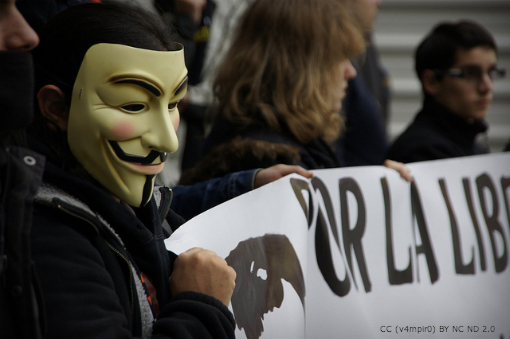Freedom of expression violations on the online environment
by Digital Rights LAC on October 21, 2013
By Heloisa Padija, Julia Lima and Laura Tresca
On the online environment, freedom of expression violations can be defined out of the wide range of variables which are commonly linked to the web, such as web neutrality violations, surveillance practices, restrictions to file sharing, among others. Besides the specific violations, serious Internet-related crimes, such as homicides, attempted murders, death threats, kidnaps and disappearances, are also frequent.
What has been traditionally associated to journalism is now extended to people that elected the Internet as their main tool of expression, for instance, bloggers, owners or editors of websites and Internet users. There are notable signs which indicate that those violations have the potential of getting more and more intense against these communicators, who are generally individuals acting autonomously, without any support from the big companies of the communications sector. This reality is not an exclusive trace of a single country; it certainly corresponds to a regional panorama. Thus, bloggers’ and users’ rights to protect themselves and to fully assure their right to freedom of expression on the Internet become an emergent theme concerning web governance in the region [1].
In 2012, Article 19 did the entire registration of the gravest cases of freedom of expression violations on the online environment in Brazil and produced a report called “Threats on the web” (“Ameaças na rede”). The report aimed to characterize and to dimension the challenges of online freedom of expression in Brazil through the victims’ perspective and accounts. Unfortunately, the threats exceed the scope of judicial censorship. Journalists and bloggers are victims of frequent physical aggression, death threats and murders because of what they say on the Internet.
Article 19’s research found sixteen cases of serious threats to freedom of expression in the year of 2012. It is important to notice that it was performed an investigation in which the cases made available to the media or communicated directly to the research team were monitored and posthumously analyzed. Hence, despite all the efforts, the “Threats on the web” report is not exhaustive: there may be cases which weren’t spotted or communicated to the organization.
The sixteen registered cases of serious threats correspond to three homicides, three attempted murders and ten death threats against communicators that disseminated information, ideas and opinions on the web. The case analysis pointed out some important quantitative and qualitative aspects in order to clarify some vulnerability patterns which are favorable to the occurrence of freedom of expression violations.
About the regional aspect, the research demonstrated that the Center-West region leads the violations’ ranking, representing 43.45% of the total amount of grave offences to online freedom of expression. There were seven cases of serious violations in the region, followed up by four cases in the Southeast region and three cases in the Northeast. The North, Northeast and South regions presented fewer occurrences. However, it is important to remind that the North and the Northeast are the Brazilian regions in which it is more difficult to find households with access to the Internet and this fact can influence directly the low quantity of violations in these regions [2].
Other important aspects that were perceived during the case analysis are the gender, the motivations and the profile of the offenders. Concerning the gender of the victims threatened in 2012, 81.25% of the violations were performed against men. The quantity of violations made against women – which were three throughout the year – occurred through death threats.
A relevant fact that can help us understand why there are less freedom of expression violations against the female gender is possibly the minor quantity of women that possess sites and blogs or express themselves professionally on the Internet (comparing to the quantity of men that do so). Moreover, the female gender suffers from other types of hostilities that culminate in self-censorship and inhibit expression in a more preoccupant way, since they are not occurrences that resonate inside society in an equally impacting manner, mainly if we compare them to the serious violations inserted in the report.
On the motivations, the complaints were the major type of content that led to retaliations against the victims, presenting themselves as an element of motivation in 11 cases. Other contents that provoked violations against bloggers and journalists were criticism, opinions and information reproduction.
At last, we can also remark that the State is involved in the majority of the analyzed cases, through the hands of politicians that occupy official positions in different spheres of power, mainly in more local and policed levels. Together, these two actors represent 62% of the serious cases of freedom of expression violations. The offenders that are not related to the State are linked to other functions, such as entrepreneurship and organized crime, each representing 19% of the cases.
The identification and the deep analysis of a problem are preliminary phases in the adoption of measures which can be able to solve it. The report cited in this text expects to give the necessary visibility to a very serious problem in order to incite authorities’ actions, preventing future problematic cases and giving a solution to the old ones. Besides the non-violation of human rights, the State is also obliged to take positive measures to prevent any kind of attack that aims to silence people on the web, even if the violent actions are performed by other actors. Therefore, we do believe that this theme is becoming an emergent topic on web governance in the region.
[1] The topic will be discussed in a workshop organized by UNESCO, CELE and ARTICLE 19 during the IGF 2013.
[2] The data were taken from a research made by Cetic.br, a CGI organization responsible to the analysis of the web behavior in Brazil, concerning the year of 2012. The research can be accessed through the following link: http://www.cetic.br/usuarios/tic/2012/A4.html.






